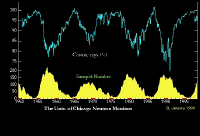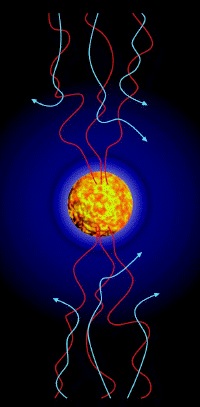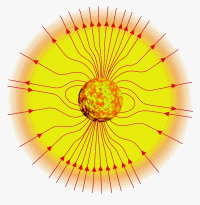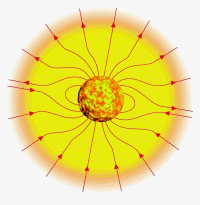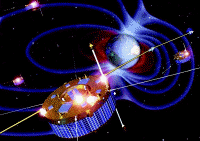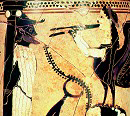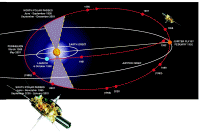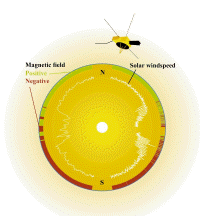Ulysses: the Sun around us
How the sun fights the cosmic rays
Energetic particles that bear down upon us from distant parts of the Universe can damage living tissue and cause computer faults, and may affect the weather. The Sun helps to shield the Earth from these cosmic rays. Their intensity declines whenever the presence of many sunspots tells of high solar activity (see diagram.)
Figure 3. Sunspots up, cosmic rays down. Colorado neutron counts by Univ. Chicago (Ulysses/COSPIN leaders)
Ulysses confirmed and discovered various ways in which the Sun hampers and weakens cosmic rays before they reach us. Strong bursts of gas from the Sun repel cosmic rays. So do the shocks produced by colliding fast and slow solar wind-streams near the equator. The shocks are rhythmic because they rotate with the Sun. Ulysses found unexpectedly that the Sun's polar regions feel these rhythmic shocks coming from the equatorial zone.
|
Figure 4. Polar magnetic field lines are folded and kinked | |
|
|
In contrast to the solar wind, which flows much more steadily in the polar regions than it does near the equator, the magnetic field near the poles fluctuates erratically. The shifts are caused by large-amplitude waves travelling outward from the Sun. Polar magnetic field lines are folded and kinked. They shove cosmic rays away from the Sun and back into the outer heliosphere, just as a raging surf forces a would-be wader out of the ocean and onto the beach.
The intensity of cosmic rays is essentially the same over the Sun's poles as it is at the equator. Astrophysicists had reasoned that magnetic fields should converge toward the Sun's north and south magnetic poles, just as the field lines around a bar magnet do. From the point of view of cosmic rays, the field lines over the poles should act as magnetic funnels, concentrating the rays and increasing their intensity (diagram bottom, left). Ulysses found that this picture was wrong. The solar wind spreads the field lines more uniformly (diagram bottom, right).
"We went to the south magnetic pole of the Sun and it wasn't there!" was how André Balogh of Imperial College London expressed his surprise in 1994, when Ulysses first revealed the nature of the polar field.
Sensors on Ulysses identified atoms wafting into the Solar System from the thin gas that fills the space between the stars. From neutral helium atoms, Ulysses established the speed and direction of the Sun's motion relative to the gas. The proportions of various atoms in this local interstellar gas found by Ulysses are helping to reveal how the material from which the Solar System was made has aged.
From much farther away, Ulysses registered an intense burst of gamma rays from a new class of neutron star, a magnetar, 20 000 light-years away. Despite the immense distance, the five-minute radiation burst was strong enough to disturb the Earth's atmosphere.
Star-dust showers us from cosmic space
|
| |
|
Eberhard Grün | |
|
|
"The interstellar grains detected by Ulysses are bigger, and it is now thought that they may even reach the orbit of the Earth," said Eberhard Grün of the Max-Planck-Institut für Kernphysik in Heidelberg, Germany. "This discovery provides the opportunity to analyse real stardust - the raw material that the Earth and the planets were made of."
Shooting stars, or meteors, are small grains of dust from interplanetary space, burning up in the Earth's air. Space physicists used to think that all dust in our vicinity came from asteroids or comets. Yet, deep inside the Solar System, the DUST instrument in Ulysses collected and analysed grains of interstellar origin. Small dust grains the size of cigarette smoke (about 0.01 to 0.1 microns) are prevented from reaching the inner regions of the heliosphere because of the magnetic field of the solar wind.
In 1998 Ulysses revisited the orbit of Jupiter and began a second trip to the Sun. It continues to operate flawlessly and has enough attitude- control fuel and electrical power for at least one more orbit, taking it over the solar poles in 2000 and 2001.
If anything, the coming inspection of the polar heliosphere will be even more interesting than the first, which took place when the count of sunspots was at a minimum and the Sun was relatively quiet. The next visit will be at the height of the sunspot cycle, a time of solar frenzy. Investigators are already booking seats for a display of pyrotechnics much grander and more spectacular than the Earth-bound fireworks that will herald the new millennium.
Earth's space environment: ESRO-II to Cluster
Power cuts, communication blackouts, auroras and damaged satellites are all caused by high-energy solar particles penetrating Earth's magnetic shield. Over the last thirty years, studies of near-Earth space by ESA and its predecessor ESRO (European Space Research Organisation) have significantly increased our knowledge of such events.
Figure 7. Cluster (Dornier Space Systems)
The programme began with the launch of ESRO-II in May 1968. Two more satellites followed over the next seven months. Exciting new information was obtained on Earth's radiation belts, the ionosphere and the aurora borealis (northern lights). HEOS-1 returned new data on the shock wave created by the solar wind as it slammed into Earth's magnetosphere, while HEOS-2 explored the boundaries of Earth's magnetic field. These and further satellites revealed the secrets of basic physical processes taking place in near-Earth space, such as collisionless shocks and magnetic reconnections.
The next step is to send four identical spacecraft around the Earth. The Cluster mission will give the first three-dimensional view of the ever-changing sea of plasma around our planet.
|
| |
|
Gerhard Haerendel | |
|
|
"The cosmos starts a few hundred kilometres above our heads," said Gerhard Haerendel of the Max-Planck-Institut für Extraterrestrische Physik in Garching, Germany. "If we can understand what is happening close to the Earth, we can apply that knowledge and understand similar processes in the rest of the Universe."
Last updated: 03 April 2001
Gale force winds in most of the Sun's empire
|
| |
|
C.M. Dixon | |
|
|
"Don't miss the chance to experience the unpeopled world on the far side of the Sun," Ulysses the sailor told his crew, according to the poet Dante Alighieri in Inferno Canto XXVI. Non vogliate negare l'esperienza di retro al Sol, del mondo senza gente.
Interplanetary space is nothing like the vast and tranquil void so often imagined. The Earth swims deep inside the heliosphere, a huge cavity of the local interstellar medium filled by an outward-racing plasma of charged atoms and electrons from the Sun called the solar wind. This wind is very different from its meteorological namesake that sweeps the surface of the Earth, but its gusts and shocks, causing aurora and magnetic storms, may affect our weather and can harm satellites, power supplies and communications.
Figure 1. Ulysses and its orbits
In 1990 the Ulysses space probe, built by European industry for the European Space Agency, was launched by a NASA space shuttle on an unprecedented journey of discovery. The gravity of the planet Jupiter deflected it into an orbit taking it over the Sun's poles.
With an array of sophisticated sensors for gauging the invisible winds, atoms, dust grains and magnetic fields that permeate space around the Sun, Ulysses passed 300 million kilometres above the Sun's southern and northern poles, a region never studied before.
Figure 2. Ulysses (ESA & NASA): SWOOPS and MAG
Ulysses has explored the solar wind from all angles, producing the first three-dimensional picture of the heliosphere. It found that the wind from the cooler regions close to the Sun's poles fans out to fill two thirds of the heliosphere, and blows at a uniform speed of 750 km/s, much faster than the 350 km/s wind that emerges from the Sun's equatorial zone.
The Sun's magnetic equator is also influential. As the Sun rotates, its magnetic equator appears to wobble up and down. The solar wind in the region occupied by the Earth therefore alternates between fast and slow. Before the slow solar wind has time to reach the Earth's orbit, the fast wind overtakes it. The result is a high pressure front, equivalent to a weather front on Earth. Much of our "space weather" is caused by the shock of such interplanetary fronts.
"Just like the mythical character after which it was named, the Ulysses spacecraft has ventured on a voyage of discovery," said Richard Marsden, ESA's project scientist for Ulysses. "Its findings have changed for ever the way we view the Sun's environment, the heliosphere."

